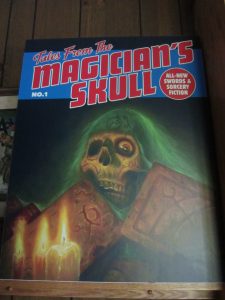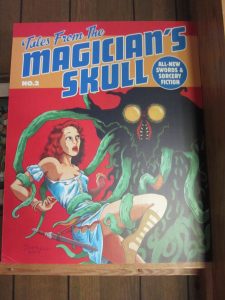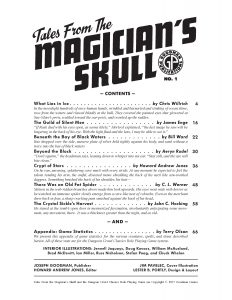Editorial Choices
 Back in May, my friend Keith asked for a few more details about what goes on behind the scenes at a magazine. Specifically, he wrote: “I’d love to read about what it’s like to edit a magazine, not just about submissions and what you look for in a story (although that is of much interest), but what all is involved in putting a publication together. In other words, I’m interested in the nuts and bolts of what goes on behind the scenes.”
Back in May, my friend Keith asked for a few more details about what goes on behind the scenes at a magazine. Specifically, he wrote: “I’d love to read about what it’s like to edit a magazine, not just about submissions and what you look for in a story (although that is of much interest), but what all is involved in putting a publication together. In other words, I’m interested in the nuts and bolts of what goes on behind the scenes.”
I can’t speak from a position of great authority, as I’ve only worked on two magazines, but I can speak with familiarity about Tales From the Magician’s Skull, the caveat being that each issue has been a little different. With the third issue underway, though, it feels as if routines are getting into place.
 Issue 2 is currently at the printers, but I’ve already begun soliciting stories for issue 3. Top on the list are either authors I’ve been planning to contact (I’ve a long list of people I want to get into the magazine) or writers who have already had series characters appear in the magazine. Our intention is to get a variety of old and new into every issue.
Issue 2 is currently at the printers, but I’ve already begun soliciting stories for issue 3. Top on the list are either authors I’ve been planning to contact (I’ve a long list of people I want to get into the magazine) or writers who have already had series characters appear in the magazine. Our intention is to get a variety of old and new into every issue.
Once the stories come in, I read them. Sometimes I suggest some changes and a back and forth begins with the writer that may take multiple passes. Sometimes I like it well enough that I send it straight on to publisher Joseph Goodman for final consideration. Sometimes the story isn’t quite right for the magazine. Because I’m not opening to general submissions yet I’m getting professional work, so the choice whether to include or not really comes down to tone rather than proficiency.
If Joseph has changes or issues the story goes back to the writer, and sometimes there are back and forths and brainstorming sessions about titles.
Once a story is accepted Joseph starts lining up art, and that’s completely his bag, not only because of his connections after years of hiring illustrators for games, but because he’s actually studied art and, unlike me, has some artistic skill. When I’m about two-thirds of the way through picking content I write our advertisers to see if they’re interested in coming on board for another issue, and occasionally I get contacted by new advertisers. When the ads come in I send them on to Joseph and Lester, our layout genius.
 Lester doesn’t start real work on the issue until he gets all of the advertisements and stories in one big batch. Usually by then I’ll have determined an order to the stories, but sometimes I’ll keep playing with the order even through layout stage. I hope to avoid that in the future, but with issue 2 I couldn’t help myself. I like to lead and finish with strong action pieces, and I like to put the more divergent in tone deeper in the issue, interspersed with those more squarely under the sword-and-sorcery banner. I like to vary the feel of the pieces so that we don’t have the same kind of tone in each story, one after the other.
Lester doesn’t start real work on the issue until he gets all of the advertisements and stories in one big batch. Usually by then I’ll have determined an order to the stories, but sometimes I’ll keep playing with the order even through layout stage. I hope to avoid that in the future, but with issue 2 I couldn’t help myself. I like to lead and finish with strong action pieces, and I like to put the more divergent in tone deeper in the issue, interspersed with those more squarely under the sword-and-sorcery banner. I like to vary the feel of the pieces so that we don’t have the same kind of tone in each story, one after the other.
After issue 1 we started getting letters, and I expect the same thing will happen when issue 2 gets released as a full-fledged print magazine. As the letters trickle in Joseph sends them along and I channel the skull in answering them. That’s honestly a whole lot of fun. Some of the last pieces we put together are the editorial, and a word from the Skull. We also vary the titles on the pile of books that the Skull is sitting on in the illustration associated with the Skull’s observations.
After Lester makes his first pass I read it, Joseph reads it, a copyeditor reads it, and all of the authors get sent a copy as well. Lester then addresses any changes and Joseph and I read through it a final time. After that Joseph takes over and runs it through the printing gauntlet. I’m not sure what happens there.
For the first two issues, Joseph selected the cover art ahead of time. We’ve just started discussing what piece ought to be featured on the cover of issue 3, so going forward I think Joseph may be planning to have the illustration tied to the material within the magazine.
Keith, is that everything you were curious about? Anything more you want to know, or something I’ve left out?
Addendum 1: I neglected a step with which I have minimal involvement. Once all the stories are in, Joseph passes them on to our Dungeon Crawl Classics guru, Terry Olson, who decides what objects or creatures deserve a write-up in DCC rules, so that they can be used in games inspired by the stories. He creates not just the rules, but the snappy text that describes the monster or treasure item.
Addendum 2: There are maps. Sometimes an issue will have more stories where a map can be used than others. Joseph and I both like maps, so once all the stories are in the two of us trade ideas about which ones could benefit from one, and then he contacts one of his illustrators, gives them the story and a few guidelines, and they get to work.
1 Comment